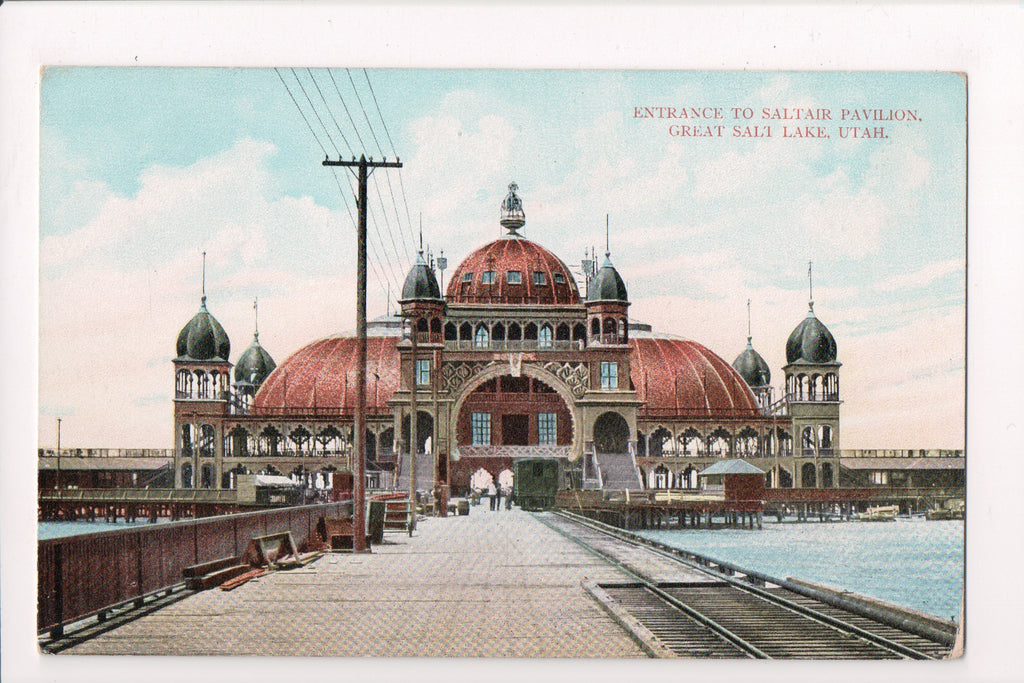-----
 |
| The Saltair Pavilion in happier days, with the tracks ending. (Kathy's Postcard Emporium) |
The history of the Salt Lake, Garfield, and Western Railroad (SLGW) began in 1893 with the completion of the first Saltair resort building on the Great Salt Lake itself. The enormous amusement pavilion rested on 2000 posts and pilings on the Southern end of the Sale Lake, and was designed from the start to be a "Coney Island of the West", under Mormon supervision to disallow any gossip and provide the devout with a place that wasn't so "spiritually bleak." To serve the resort, a railroad line was established before construction began, on September 6, 1891, calling itself the Salt Lake & Los Angeles Railroad (SL&LA).
 |
| An empty "Saltair" train and 10 empty "suburban-style" coaches (plus one combine) await to depart the Pavilion, bound for Salt Lake City (LDS Church History Library) |
The SL&LA ran 14 miles west out of Salt Lake City to a wye, before turning northwest towards Saltair Beach. The South end of the wye went to Saltair Junction and the Inland Crystal Salt Works. The Salt Works had their own line, dubbed the "Inland Railway", which then looped back to Crystal Junction in Salt Lake City. The Saltair Beach line ran just half a mile from the shore to the pavilion itself, itself on a massive number of pilings perched atop existing salt flats. Passenger service was originally operated by steam locomotives, one at either end of the train, sandwiching ten, often twelve or even sixteen, enclosed and open "Suburban-style" passenger cars to give patrons a fresh dose of invigorating salt air.
 |
| A map of the Saltair Railroad, 1916-ish. (Donstrack) |
 |
| A San Pedro, Los Angeles, and Salt Lake Shay crew at Milford, Utah, early 1900s (Utah State Historical Society) |
The "Saltair Railroad" ran successfully into the 20th century with most of the profits coming from tourist services. The salt mining service at the Inland Crystal Salt Works was profitable to keep going, but by 1906, the Church had divested control of the resort to the railroad and the Snow family. The railroad was renamed to the "Salt Lake, Garfield & Western" in 1916 to avoid confusion with the Union Pacific's "San Pedro, Los Angeles & Salt Lake" line (which had just that year dropped "San Pedro" from its name). With this change in name and responsibilities, the railroad saw it high time to finally join the rest of the US and electrify.
 |
| New Saltair Car No. 503 poses with some passengers, very much resembling a Chicago interurban car. (Gordon Cardall, Donstrack) |
 |
| A Saltair mix rumbles along behind Steeplecab No. 401, with a homebrew "suburban car" right behind it." (SLGWRailway.com) |
Electrification was complete in 1918, and all six electric cars began going back and forth between Saltair and Salt Lake with the Saltair name emblazoned on their sides along with a handsome Pullman Green and Orange livery. The freight lines would also find electrification with Baldwin-Westinghouse steeplecab No. 401, originally from the Salt Lake and Utah Railroad. The Saltair even found room to expand, opening a station at Garfield by 1919 one mile from the town to serve the booming copper industry. Unlike many railroads, the Saltair was never in any serious threat from the automobile or from incoming buses, but that did not stop the 1920s from bringing catastrophe to the line and the resort.
 |
| Saltair Car 503 and another unidentified one hauling a long line of boxcars in Sale Lake City, displaying the versatility of these interurbans. (Phil Lavorgna, Donstrack) |
In 1925, the Saltair Resort (retroactively, Saltair I) was destroyed by fire on April 22, 1925. A new facility was immediately built and expanded upon, dubbed "Saltair II", but popularity for the new dance hall waned due to the advent of motion pictures, radio, and the eventual Great Depression keeping everyone home. To offset the low passenger count, the SLGW pressed their passenger cars into freight service (as they could haul up to 40 fully loaded boxcars), but disaster would strike again as Saltair II (now losing money due to the popularity of tropical vacations) caught fire and then the Salt Lake itself would recede significantly, necessitating a miniature speeder car railway to reach the water.
After WWII, the Saltair II attempted to reopen but it was still plagued with problems from the 1930s: too many options and stronger competition. 1951 saw the biggest shakeup to the roster when two General Electric 44-tonners were purchased secondhand in December. The six interurban cars were rebuilt as trailers and diesel-hauled for two years, before all but two electric cars were scrapped in 1953. A diesel railcar would take over passenger duties until 1958, when all passenger service was suspended following closure of the Saltair II. Today, a new Saltair III pavilion exists on the shores of the Great Salt Lake off Highway I-80, and the SLGW continues to operate as a mainline freight interchange between the Union Pacific and Burlington Northern Santa Fe.
 |
| Diesels come to the Saltair, 1951 (Donstrack) |
-----

No comments:
Post a Comment